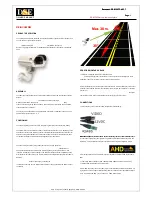
13
3. TTL flash mode
Fig.6 : Measuring scheme for TTL mode
The direct way to good flash shots
In TTL mode, the exposure readings are made by the sensor built into the
camera (Fig. 6). This sensor measures the light reaching the film through the
camera lens. An electronic control circuit within the camera transmits a stop
signal to the flashgun as soon as the film has been exposed by the correct
amount of light; the flash is then instantly cut out.
The advantage of this flash mode is that all factors influencing the correct exposure
of the film, such as filters, change of aperture and focal length with zoom lenses,
extensions for close-ups, etc. are automatically taken into account.
The TTL flash mode can only be carried out with cameras that feature
this function. The flashgun must be fitted with a corresponding SCA
adapter (see SCA 300/3000 system instructions and SCA survey table).
Exposure corrections may be necessary with pronounced differences
in contrast, for instance dark objects in snow (see ch. 15, p. 54).
12
☞
Ǻ
3. TTL flash mode
Fig. 7: Settings for TTL mode
Setting procedure for TTL mode:
•Adjust the camera according to the manufacturer’s Operating Instructions.
•Fit the flashgun with the appropriate SCA adapter and mount it on the camera.
1
Switch on the flashgun with the main switch
.
2
Set the operating mode selector
to
TTL
.
•
*Press the
ISO
button
and adjust the film speed with the „
+
“ or „
-
“
button
.
•
*Press the
ZOOM
button
and use the „
+
“ or „
-
“ button
to adjust the
zoom value selected with the camera’s lens.
•
If necessary, press the
P
button
and adjust the partial light output level with
the „
+
“ or „
-
“ button
(e.g. in winder mode).
•
*Press the button
and use the „
+
“ or „
-
“ button
to adjust the same
aperture as on the camera.
*
must additionally be set on some cameras
.
In the event that film speed and aperture are not transmitted auto-
matically, there is no need to make these settings manually; they are
insignificant for a correct exposure. They are, however, necessary for
correct indication of the distance.
Sensor
1
2
☞










































